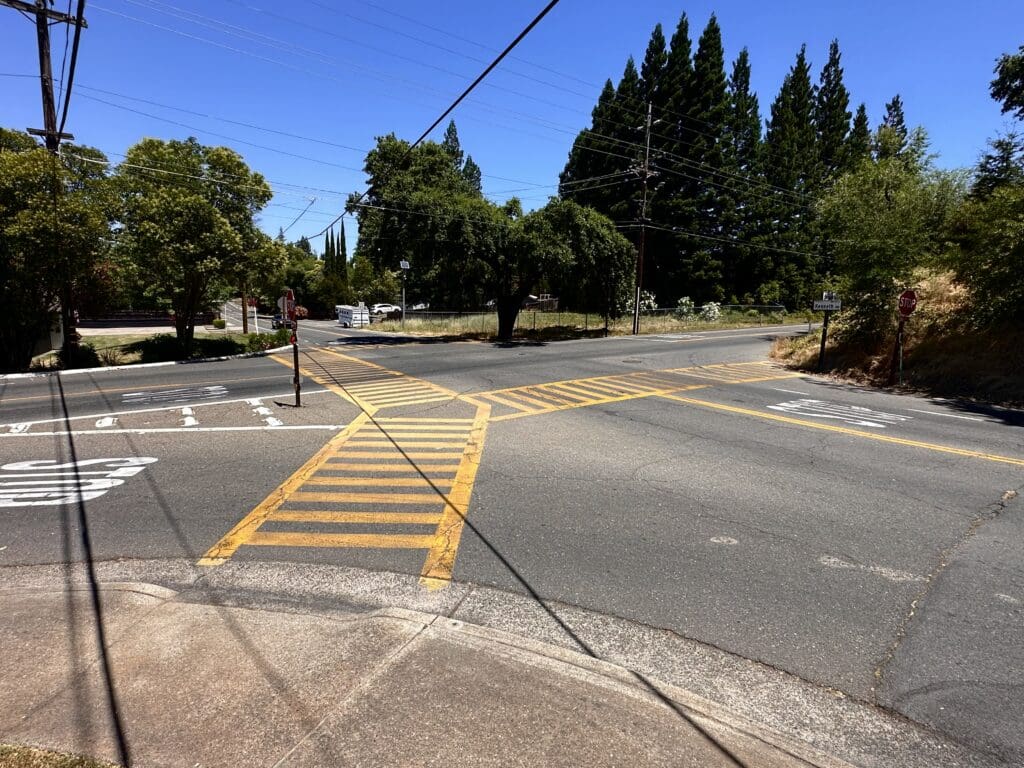
By Abigail Hoiland
On a warm day in late September, 2023, I was biking to school to pick up my kids. I passed a boy in a crosswalk outside school and smiled and waved to him as we crossed paths. Moments later, I heard a crash. Someone yelled, “It’s the kid!” I stopped and made a u-turn and immediately called 911. Fortunately, one woman on the scene was a nurse. She’d seen the crash first-hand and soon had the boy lying down on the grass. The paramedics came, as did the principal, and I took down phone numbers of witnesses. Amazingly, despite being knocked off his bike, rolling onto the car’s hood and breaking the front windshield, the boy was relatively unharmed. He was able to walk away with just a scraped knee.
After the crash, parents inundated our county board supervisor with requests to reinstate the crossing guard program that was dissolved in 2020 amid concerns about mounting costs, to no avail. Unfortunately, this is not a problem that is confined to unincorporated Sacramento, where I live. Many other cities including Memphis, TN, Lawrence, KS and San Jose, CA report similar constraints.
Alarmingly, there have been three incidents in that crosswalk since the crossing guard was removed.
This is how I wound up becoming a volunteer crossing guard. I already had a STOP umbrella and a fun collapsible traffic cone hat I made for visibility when walking our trick-or-treaters around at Halloween. I tried to make crossing the street as safe and upbeat as possible. I played Dixieland music out of a megaphone to lighten the mood. I created a large banner that read, “Please Take A Breath And Enjoy The Music,” to encourage drivers to slow down and stop for us. I made signs that listed the school’s release times to give drivers a heads-up about when they should expect vehicular traffic to slow at the intersection. My interventions seemed to do some good, but the number of times cars came too fast within inches of me was still uncomfortably high.
As a volunteer crossing assistant, I had no real authority over the intersection and it became quickly apparent to me how difficult the job was. The task was made significantly more challenging by the complexity of the intersection – a four-way stop with an additional right-hand turn lane and three crosswalks. Drivers were anxious to get where they were going and students didn’t always want to wait for me to get back from the far crosswalk to help them be seen as they crossed. Drivers raced to get through the intersection right before I reached their car or immediately after I passed. People driving in such close proximity was terrifying. My heart raced daily.
I reached out to the sheriff’s office and California Highway Patrol for help. The police department had just received grant money to increase its presence at schools, but they were only able to help us once or twice a month due to the number of schools in our district. I kept sending emails to the school district and county trying to find out what their plan was to fix this unsafe crossing situation. I was repeatedly told they didn’t have the money to do anything.
A local news station got wind of the problem. They did a beautiful job publicizing our crossing challenges.
But three months after I began my volunteer crossing guard duties, I turned in my yellow vest. Realizing my presence in the crosswalk took pressure off the local government to fix the problem, combined with the fear for my life I felt every time I stepped into the street, I made the hard decision to stop. I wrote notes to all the parents of children I crossed notifying them that I would no longer be at the crosswalk, and I urged them to talk to their children about safer crossing practices. My heart aches every time I see students crossing out there alone.
When I was a child, my father was stationed with the family in Stugart, Germany from 1992-1995. These were the best years of my childhood. I was free as a bird from sunrise to sundown, and it was safe. I desperately want my kids to have the safety to roam our neighborhood as I did in Germany. We moved to Sacramento County to own a home and be closer to my sister. We love the people and greenery here, but pedestrian safety does not exist.
Still, I’m not giving up. Although I’ve discontinued my crossing-guard work I was recently elected to the entity overseeing expenditures at my children’s school, where I continue to lobby for improved crossing safety.
-Abigail Hoiland is a freelance graphic designer, a former elementary school teacher, and the mother of two children.
Further reading on school street improvements for kids:
Infrastructure and policy changes could improve school safety and minimize the need for school crossing guards in the first place. See this inspiring example from Paris, one of several European cities that have embraced the idea of closing streets outside of schools to cars altogether and making them beloved public spaces.
Some U.S. cities, including Seattle, Portland and Chicago, not ready to close streets down to cars permanently have opted to bar motorized traffic during school drop off and pick up times.